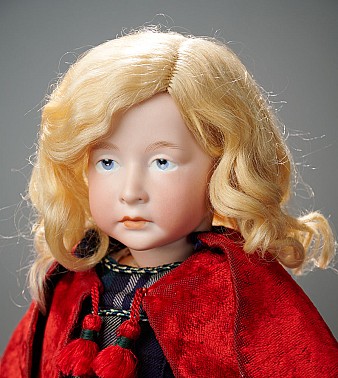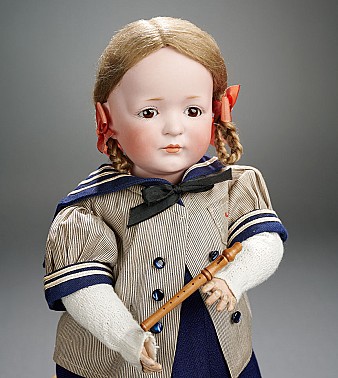Extremely Rare American Composition Set of Little Nemo Character Dolls
Sep, 2024
13" (33 cm.) -15". Each has composition head with uniquely sculpted and painted facial features and hair to represent the story character, along with characteristic accessories such as spectacles of Dr. Pill and green upper face of Flip the Clown, each with original firmly-stuffed muslin body with composition hands and sewn-on black cotton feet designed to appear as shoes, and each is wearing original costume appropriate to its character. Condition: generally excellent, all original. Comments: American, the likely maker was Louis Amberg, circa 1915, inspired by the comic strip "Little Nemo" created and drawn by Winsor McCay and appearing in the New York Herald from 1905 for more than six years and then another three at the New York American. The characters include Little Nemo, The Princess from the Candy Islands, Impy the Black doll, Flip the Clown, and Dr. Pill. Value Points: the extreme rarity of the only complete set known to exist is further enhanced by the remarkable state of preservation of the dolls and their costumes. Included with the set are two early postcards by Tuck and a later publication of the book "Little Nemo in Slumberland" (1941, Rand McNally) with McCay illustrations. Now these five dolls, believed to be the only complete set known, has appeared from the estate of the late Gwen Pogue of La Mesa, California.Background: "Little Nemo was a boy who never made a fuss about going to bed on time" begins the story of Nemo who rushed to bed each night so he could enter the wonderful dream world of his Slumberland. Little Nemo and his adventures came to life in an early comic strip first appearing in the New York Herald in 1905. Nemo ("no one" in Latin) was a lonely little boy whose life was made exciting by his dream adventures which abruptly ended each morning as he awoke.The popularity of the comic strip is credited not only by its imaginative storylines, but also by the exceptional talent of its artist/author Winsor McCay (1866?-1934). His fantastical artwork in Art Nouveau style was unique in its time, foreshadowing the later graphic styles of the Fleischer studios and Walt Disney's feature films. McCay, is, in fact, named by some historians as the "greatest comic artist of all time", a pioneer of animation as well as illustration.In the story line, Little Nemo meets with a regular, yet ever expanding, cast or characters which included The Princess from the Candy Islands, Impy the black doll, Flip the Clown, and Dr. Pill. So popular was the comic strip that in true American spin-off fashion, it inspired the creation of related merchandise, ranging from rolly-dollies to postcards to bisque figurines by Schafer and Vater. and toys such as a beanbag toss toy by Bliss and bell toys each featuring the characters from the story line.Perhaps rarest of all this related "merch" was a set of composition dolls depicting the characters from the strip. Over the year, collectors have hinted at the existence of these dolls, but no one could find such a set.





































































































